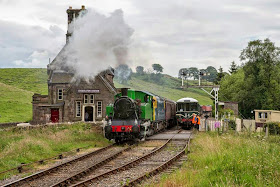Please click on any picture for a larger image.
Outside the Barton control tower; Vic, Gordon, Peter, Sue, Ross, me. Peter, Ross and me are currently Concorde and Nimrod guides at the Runway Visitor Park. Vic and Gordon are ex-guides, while Sue used to be guide coordinator and in charge of visitor reception.
First port of call was the Tower, with three AFISOs (Airfield Flight Information Service Operators) on duty. AFISOs are a sort of half-way house between Air Traffic Control and Air-Ground Radio. They can control traffic on the ground but not in the air, and the existence of the 'half way house' AFISO service is controversial in some quarters of General Aviation where it is argued that if full ATC is not required, then Air Ground Radio is a less cumbersome and more straightforward way to handle traffic than the AFISO solution.
Peter, Ross, Vic, and Gordon the Tower
The view to the west from the Tower. The Brian Harbit hangar to the left with the Airfield Lodge cafe beyond. Behind the Lodge can be seen the original buildings of Foxfield Farm which became the aerodrome terminal buildings when the airfield was built on land owned by Manchester Corporation Cleansing Department for the tipping of 'night soil'. The portacabin array next to the farm buildings is from the Salford Quays development for Media City (a Peel Holdings venture) and is intended to house the flying schools and the Visitor Centre.
In the Harbit hangar, a Steen Skybolt
....And long-time Barton member Russell's aeroplane, a Taylor Titch which boasts a supermarket trolley wheel as its tail wheel and a steam iron control dial as its throttle quadrant!
Here's the one that started it all for me, Cessna 150 G-AYGC. One summer evening in 1978 Tom Dugdale walked away from this aeroplane after I'd had a lesson of flick-entry spins with him saying "my next student has cancelled, so how do you fancy having a go on your own?". I had about 10 hours instructed flight time time in my log book so wasn't expecting a first solo just yet, but Tom knew what he was doing and it was just the confidence booster I needed! Metaphorically, I didn't come down from that flight for about two weeks!
This Edge 360 is a dedicated aerobatic competition machine. Note the fully symmetrical wing - same cross-section profile on the top surface as on the bottom, and flat with no dihedral or anhedral. So much for that drivel in all school 'O' Level physics textbooks claiming aeroplanes fly because of the convex upper surface profile and flat lower surface profile. This aeroplane flies superbly, so such books and such lazy authors should be consigned to the rubbish bin!
Anyone who seriously wants to know how an aeroplane flies, and why it sometimes stops flying, should read an old but brilliant book called 'Stick & Rudder'. And then go consolidate and prove the gems of wisdom in that book by flying an aeroplane! Preferably an aerobatic aeroplane!
This rather nice Boeing Stearman lives in the Keenair hangar at Liverpool airport where our Chipmunk used to reside before it moved across to the Ravenair hangar. The new owner of this aeroplane and of the Tiger Moth from the same hangar was being checked out on the Stearman by Martin Rushbroke, Barton's top instructor who taught me aerobatics in the Chipmunk and checked me out in the Yak 52. Martin is as much a total aviation person as one can find, and an excellent instructor.
The Stearman has a Lycoming engine, but not one of those boring flat fours. This is a 9-cylinder radial!
We retired to the Airfield Lodge (formerly Lancashire Aero Club's clubhouse) for a coffee
After coffee we had a look around the Visitor Centre...
...Which includes some picture of our Chippy in original (when we got it in 1979) blue, then red (above) and also in its current black livery
Outside the Visitor Centre; Peter, Vic, Sue, Ross, Gordon
Thanks to Vic for arranging this great morning out!
.





















































